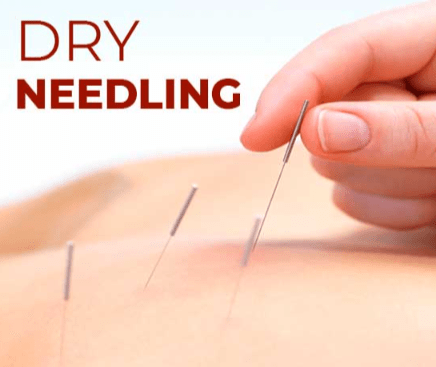What is Dry Needling?
Dry needling is a therapeutic technique trained healthcare professionals use to relieve pain, release muscle tension, and improve movement. The treatment involves the insertion of thin, sterile needles into specific points within muscles, known as trigger points, or areas of tightness and dysfunction. These needles do not contain medication—hence the term “dry” needling.
Dry needling aims to stimulate the body’s natural healing processes by releasing muscle knots, reducing inflammation, and restoring normal muscle function. This technique can address various conditions, including chronic pain, sports injuries, and muscular tightness caused by stress or overuse. While dry needling may initially feel unfamiliar, many patients report significant relief and improved mobility after treatment.
Jump to A Section

Who Can Perform Dry Needling?
Dry needling is a specialized technique that should only be performed by licensed healthcare professionals who have undergone proper training and certification. In many regions, physical therapists, chiropractors, and other qualified practitioners are permitted to perform dry needling, provided they meet the required standards of education and hands-on experience. Regulations vary by state or country, so it’s important to confirm that your provider is authorized to offer this treatment in your area.
A skilled practitioner, such as our own Emily Rotert, should have an in-depth understanding of human anatomy, muscle function, and trigger points to ensure the treatment is both safe and effective. At Red Rock Physical Therapy and Wellness in McHenry, Illinois, Debbie’s advanced certifications and extensive experience in manual therapy make her uniquely qualified to provide dry needling as part of a comprehensive care plan. Always choose a provider who prioritizes your safety, comfort, and therapeutic outcomes when seeking dry needling treatment.
The Importance of Finding a Skilled Physical Therapist for Dry Needling

Choosing a qualified and experienced physical therapist for dry needling is crucial to achieving the best results. A skilled physical therapist understands the body’s anatomy, the science behind trigger points, and the nuances of treating various conditions safely and effectively. They will take the time to assess your unique needs, create a personalized treatment plan, and monitor your progress to ensure optimal outcomes. Additionally, a good physical therapist will communicate openly, answering your questions and addressing any concerns you may have. At Debbie’s clinic in McHenry, Illinois, her extensive training and over 20 years of experience make her an expert in dry needling and other advanced manual therapy techniques. Her compassionate and patient-centered approach ensures that every treatment is delivered with the utmost care and professionalism.
What to Expect at Your First Dry Needling Treatment
During your initial dry needling session, Debbie or her staff will begin with a comprehensive assessment of your condition, medical history, and treatment goals. She will explain the dry needling process in detail, addressing any concerns to ensure you feel comfortable. The treatment involves the insertion of very fine needles into specific trigger points or areas of tightness in your muscles. You may feel a mild twitch or slight discomfort as the needle targets the source of tension. This is normal and often a sign that the therapy is effectively releasing tension. After the session, some patients experience immediate relief, while others may notice improvement over the next day or two. Mild soreness is common and typically subsides within 24-48 hours.
What to Expect at Follow-Up Dry Needling Treatments
Follow-up sessions build on the progress made during your initial treatment. Debbie or Emily will evaluate your response to the first session and make adjustments to your treatment plan as needed. Subsequent treatments often focus on refining muscle balance, improving mobility, and addressing any lingering areas of discomfort. With regular sessions, many patients find that the benefits of dry needling last longer and their overall symptoms diminish significantly. As your condition improves, the frequency of treatments may decrease, transitioning you toward maintenance care or a home exercise program to sustain your results. If you are wondering how long physical therapy will take, it will typically last between 2-8 weeks. Each session is tailored to your recovery journey, ensuring you receive the most effective care possible.
How Often Should You Do Dry Needling?

You may be wondering, “How often do I need dry needling?” The frequency and number of dry needling sessions varies depending on the individual, the condition being treated, and how the body responds to therapy. Acute pain often benefits from 1–2 sessions per week, while chronic pain may require less frequent treatments, such as 1–2 times per month. Acute cases might resolve in 2–3 sessions, whereas chronic conditions could need 6–8 or more treatments. A skilled physical therapist will assess your needs and design a personalized plan that ensures you achieve the best possible results. The goal is to provide enough sessions to address pain and restore function while allowing your body time to adapt and heal between treatments.
General Recommendations
- Acute Conditions: For recent injuries or acute pain, some individuals may experience relief after just one session. However, it’s common to require multiple sessions to achieve optimal results.
- Chronic Conditions: Chronic or long-standing issues often necessitate a series of treatments. Typically, 2-3 sessions are recommended before evaluating the effectiveness of the therapy. The benefits of dry needling can be cumulative, with relief lasting longer after each session.
Frequency of Treatment
The frequency of dry needling treatments depends on your individual needs, the condition being treated, and how your body responds to therapy. For acute conditions or recent injuries, you may experience noticeable relief after just one or two sessions. Chronic conditions, however, typically require a series of treatments, often beginning with weekly sessions. As your symptoms improve, the intervals between treatments can be extended, allowing for a more sustainable, long-term recovery. At Debbie’s clinic in McHenry, Illinois, we create customized treatment plans to ensure that each patient receives the optimal number of sessions for their unique situation.
How Long Will the Effects of Dry Needling Last
The duration of relief from dry needling varies depending on the individual, the treatment condition, and the number of sessions completed. The benefits may last several days after the first session for some patients, while others experience longer-lasting relief as they progress through treatment. Chronic conditions or deep muscle tension often require multiple sessions for sustained improvement, with relief lasting longer after each subsequent session. Over time, as muscles become more balanced and tension decreases, patients often find that the effects of dry needling can last weeks or even months. Regular maintenance sessions or incorporating complementary therapies, such as stretching or strengthening exercises, can further enhance and prolong the benefits of dry needling.
Personalized Dry Needling Treatment Plan
It’s essential to recognize that each individual’s response to dry needling is unique. Factors such as the specific condition, overall health, and treatment goals play a significant role in determining the appropriate frequency and number of sessions.
Contact an Experienced McHenry Dry Needling Clinic Near You

To develop a treatment plan tailored to your specific needs, it’s advisable to consult with a qualified physical therapist. At our clinic in McHenry, Illinois, we prioritize personalized care to ensure each patient receives the most effective treatment plan. With over 20 years of experience in physical therapy, Debbie specializes in chronic pain management, sports rehabilitation, and advanced manual therapy techniques. Her empathetic approach and dedication to patient well-being make her a trusted provider in the community.

